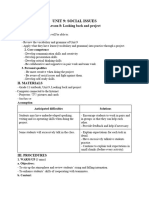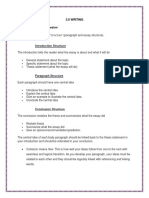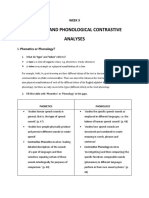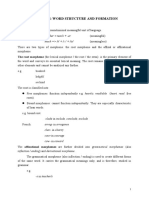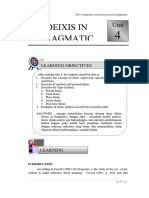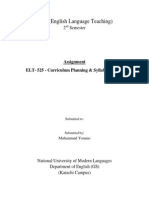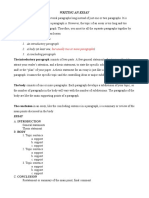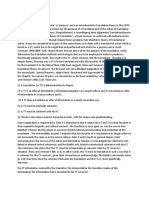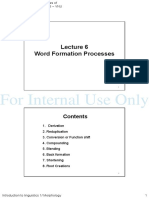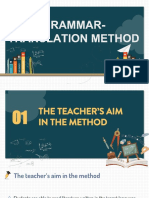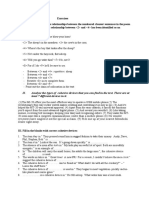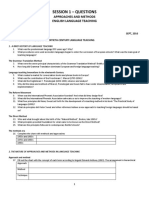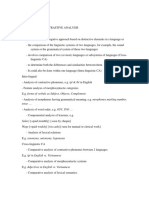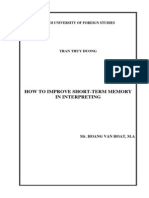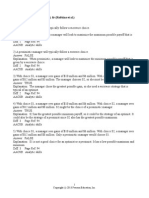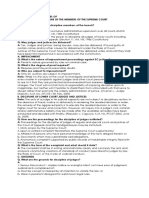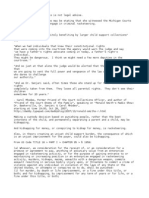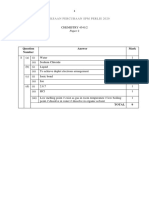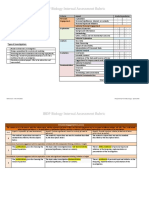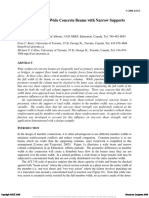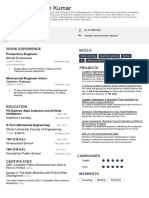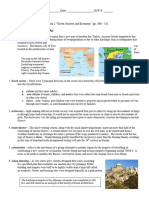Grammar Final
Uploaded by
huonglanle123Grammar Final
Uploaded by
huonglanle123I. SOME WAYS OF THINKING ABOUT GRAMMAR 1.
What is difference between the broad (global) sense and narrow sense for the term grammar? -In the broad (general) sense, the term grammar refers to all the knowledge that a native speaker has about his/ her language which enables him/her to speak and understand including all aspects of phonology and semantics, phonetics, lexicology, morphology, syntax, pragmatics. -In narrow (specific) sense which is more traditional grammar is presented as just one branch of language structure including morphology and syntax. 2. What is the difference between PG and DG? -DG aims to describe the grammar system of language exactly as it is. It tries to provide language user with constitutive rules. In this grammar, nothing is imposed. In contrast, PG is the grammar providing the language users with normative rules about how the language is supposed to be used. For example, never use double negative to express negative ideas; never end the sentence with preposition E.g: DG can accept such sentences as: I cant do nothing for you. She does not go to school last Monday. Long time no see. In contrast, PG considers those sentences wrongly and ungrammatically. 3. What is prescriptive grammar? Typical features? - Definition: Prescriptive grammar is the grammar providing the language user with normative rules by such people as dictionary publisher, editor, critics, writer and teacher Eg: Never end a sentence with a preposition. So, such sentences as Who are you speaking to? or Who did you talk with? are considered wrong. Never split a to-infinitive with an adverb. So, such sentence as They are working hard to successfully pass the exam is considered ungrammatical.
- Typical feature: Prescriptive grammar is concerned with prescribing rules of language unit. It consists of a number of rules or regulations prohibiting language use. It provides the language users with normative rules about how the language is supposed to be used. For example, never use double negative to express negative ideas; never end the sentence with preposition E.g: Such sentences are considered wrongly in PG I cant do nothing for you/ She does not go to school last Monday/ Long time no see. 4. What is descriptive grammar? Typical features? - Definition: Descriptive grammar is the grammar studying constitutive rules of language. It describes the grammar system of language exactly as it is. According to this grammar, there is nothing imposed, which is why it accepts such sentences: They dont know nothing or She arent a student. - Descriptive grammar is concerned with describing language objectively as it is actually used. It describes all language elements and grants name for them without making any judgment. It tells what the language users know unconsciously and it also enables them to use and understand the language. According to this grammar, there is nothing imposed thus such sentences can be acceptable. Long time no see./She does not go to school last Monday./I cant do nothing for you. 5. What is traditional grammar? Typical features? -TG is a grammar which is usually based on earlier grammar of Latin or Greek and applied to some other languages, often inappropriately. It studies different language elements or parts of speech separately. For example, it studies 8 parts of speech (noun, adjective, adverb), numbers, tenses -The biggest problem in this grammar lies in the fact that its not consistent internally. For example, it defines the adverb as a part of speech modifying the verb. E.g: I only love playing guitar.
But in fact, the adverb can modify other parts of speech as well. My only hobby is playing guitar. -Linguists tend to criticize traditional grammar for being based largely on intuitions about grammatical meaning, for being atomistic and not backed by an overall theory or model of grammar -This grammar, however, provides modern linguistic with a lot of terms
IC analysis is one of the most widely use technique for displaying sentence structure. It is based on the argument that different elements of language do not belong to the same layers. They belong to different layers and create different meaning. This approach works through the different level of structure within a sentence in a number of steps. At each level, a construction is divided into its major constituent and the process continues until no further division can be made. E.g: The girl helps this man. So, we can analyze the above sentence as: 1, Identifying to the major constituents: The girl, helps this man 2, Dividing the next biggest step constituent into helps and this man. 3. Continuing to divide constituents into 2 until we can go no further: The girl: The+ girl
7. What is immediate constituent grammar? Typical features? - IC grammar is a type of grammar focusing on different layers of sentence structure within the sentence to identify different meanings. According to this grammar, language elements do not belong to the same layer but they belong to different layers, creating different meaning. E.g: He satisfies the young lady with a rose. The above sentence can be understood in 2 ways: + He uses a rose to satisfy the young lady. + He satisfies young lady who is with a rose. 8.What is constituent? -Constitute is a linguistic unit (usually in sentence analysis) which is a part of a larger construction. -E.g: In the word beautiful we can single out 3 constituents: beau, ti, ful. In the phrase my lovely cat, there are 3 constituents: my, lovely, cat. In the sentence He is my best friend, there are 5 constituents: he, is, my, best, friend 9. What is immediate constituent analysis?
This man: This+ man 10. What is functional grammar? Functional grammar proposed by British linguistic Halliday is a grammar studies 3 basic functions of language. 1, The ideational function is to organize the speakers or the writers experiences of the real or imaginary world that is language refer to real or imagined person, things, action, event, state 2, the interpersonal function is to indicate, establish or maintain social relationship between people. It includes forms of address, speech function 3, Textual function is to create written or spoken texts which cohere with themselves and which fit the particular situation in which they are used. 11. What is the interpersonal meaning of the functional grammar? The interpersonal meaning is the meaning as form of action. The speaker or the writer wishes to do something to the reader or the listener by means of language. Its regulated by language users concerned. E.g: That rose in my class got bad mark again.
Rose often symbolizes beauty but for all students in my class, that means the problematic girl. 12. What is transformational/ generative grammar? Transformational grammar was proposed by the American linguistic Chomsky in 1957. Chomsky attended to provide a model for the description of all languages. Transformational grammar tried to show with a system of rules, the knowledge which a native speaker of a language uses in forming grammatical sentences. For example, this grammar studies the basic language patterns to create and transform sentences. E.g:- Sentence= NP+ VP They buy these English books. -Sentence= NP1+ V+NP2=NP2+Auxiliary+Ved+by+NP1 These English books were bought by them. IV. GRAMMAR UNITS 4.1. Morphemes and Words: Cau 1. What is morpheme, stem, root and affix? a/. Morpheme is the smallest meaningful linguistic unit of language, not divisible or analyzable into smaller forms. E.g: disagreement has 3 morphemes: dis, agree, ment. b/. + Stem (also the based form) is the part of the word which an inflectional affix is or can be added. E.g: In English, the inflectional affix est can be added to the stem hard to form the superlative hardest. + The stem of a word can be: A simple stem consisting of only 1 morpheme ( root)
Root is a morpheme which is a basic unchangeable part of the word and which may occur on its own or maybe joined to other roots. It conveys the main lexical meaning of the word. E.g: desirable- undesirable- undesirables- contain the root desire Work- worked, workable, works, worker d/. Affix: Affix is a letter or group of letters which is added to a word and which changes the meaning or function of the word. Affixes are bound forms that can be added: 1.to the beginning of the word (prefix) E.g: dislike, unemployed 2.to the end of the word (suffix) e.g: capable, beautiful, statement 3.,within a word (infix) E.g: craftsman, speedometer e/ Base: A base is any form to which other morphemes can be attached. Stems differ from roots in that they may be made up of more than one morphemes. All roots are stems, but many stems are not roots. (42). Cau2: What is an allomorph? An allomorph is any variants of a morpheme which is different in pronunciation or spelling.
E.g: /z/, /s/,/iz/ are allomorphs of the regular plural morpheme s. /t/, /d/,/id/ are allomorphs of morpheme ed indicating past tense. Cau 3: Describe the 5- rank hierarchy which is widely used as model to identify grammatical unit in the study of grammar. Give examples of each unit. The five-rank hierarchy used to identify grammatical units in the study of grammar can be described as follow: + Sentences are analyzed into clause=> phrases=> words=> morphemes. + Morphemes are used to build words=> phrases=> clauses=> sentences.
E.g: makes, larger, biggest, worked A root plus a derivation affix
E.g: scientists, teachers Two or more roots:
E.g: greenhouses, raindrops c/. Root:
E.g: The woman who lives next to my house is a very beautiful teacher. The sentence can be analyzed into: -clause: who lives next to my house -phrase: a very beautiful teacher -word: teacher -morpheme: teach + er Cau 4. What is difference between free and bound morpheme? Free morphemes are those that can stand alone as a word because they carry full semantic weight. E.g: chair, watch, teach Bound morphemes are those that cannot stand alone as a word. It only adds the meaning or grammatical function of a free morpheme. E.g: teacher => teach is a free morpheme Er is a bound morpheme. +disagree, unchanged, impatient Cau 5: What is difference between inflectional and derivational morpheme? Derivational morpheme is a kind of bound morpheme which is added to a word to make a new word, new meaning or new part of speech. It can change the part of speech of the root (root morpheme) or the stem. E.g: teach+ er=> teacher Work+ er=> worker Inflectional morpheme is a kind of bound morpheme which is added to a word in order to indicate the grammaticality, specifically, degree of comparison. E.g: tall=> taller Pretty=> prettier Rich=> richer Cau 6: what is difference between inflectional and derivational morphology? Inflectional morphology studies the way in which words vary or inflect in order to express grammatical contrast in sentences. E.g: ed can be used to form past tense: worked, stopped.. er est can be used to form comparative and superlative degree of one or two syllable adjectives.: large=> larger=> largest In contrast, derivational morphology studies principles governing the construction of new words (without reference to specific grammatical role a word might play in the sentence). e.g: V+ er=> N: work +er= worker, paint+ er= painter. Adj+ ize=> V: modern+ ize= modernize Cau 7: What is difference between lexical and grammatical morpheme?
Lexical morpheme expresses lexical meaning, referring to things, events, actions, state or properties. E.g; under, yellow, against, beautiful While grammatical morpheme expresses common meaning referring to grammatical relationship within and between sentences.
E.g: Some of the most commonly used grammatical morphemes: -s, -ed, -ing, -er,-est
Cau 8: what is difference between the compound word and derived word in English? Compound words are words formed by combining two or more roots or free morphemes together. E.g: baby-sitter, for-get-me-not, greenhouse. Whereas the derived words are words formed by adding either suffixes or prefixes or both to the root. e.g: dislike, disagreement, underdeveloped
Cau 9: What is zero derivation? Zero derivation (also known as conversion) is the formation of a new word by changing its word class part of speech without adding any affixes. E.g: to face- the face To hammer- the hammer To hand- the hand
Cau 10: the difference between word and morpheme? (40) Graphically, morpheme uses the hyphen while word does not use the hyphen. Hyphen is the distinction between word and morpheme. E.g: girl- (morpheme) Girl (word)
Cau 11: The bound morpheme -er can be used as a derivational morpheme and can also be used as an inflectional morpheme. Prove this with explanation and examples. - The bound morpheme -er can be used as a) Derivational morpheme to form new word and it can change the part of speech of the root (root morpheme) or the stem. E.g: teach+er=> teacher Act+ or=> actor b) Inflectional morpheme to indicate the grammaticality, specifically, degree of comparison.
E.g: tall+ er=> taller Pretty+ er=> prettier Rich+ er=> richer Cu 12: What is the use of ed in English language? a. To form past tense and past participle of regular verbs Eg: I will have graduated from Hanoi University by this June. b. To form compound adjective (adj + Ned) Eg: short-sighted, kind-hearted 4.2: Phrases, clauses and sentences: A. Phrases 1. What are the main ways to identify the phrase structure? 4 main ways: a. The substitution test: According to the substitution test, any word combination of the English sentence that can be replaced by a single word without changing the grammaticality of the sentence is called a phrase. E.g: Those people are very good at English. They are very good at English. Those people can be replaced by they to make a new sentence sharing grammaticality. That is why we can conclude that those people is a phrase. b. Movement criterion: According to movement criterion, any word combination of the English sentence that can be moved to another position in the sentence without changing the meaning of the sentence is called a phrase. E.g: I saw that girl in my school in July. => In July in my school I saw that girl. Although the position of the adverb, the place in the above sentences have changed, their meaning remains the same so we can conclude that In July and in my school are phrases. c. The conjoining criterion: According to the conjoining criterion, any word combination of the English sentence that can be conjoined with the similar one without changing the grammaticality of the sentence is called a phrase. E.g: we can have dinner at the restaurant. => We can have dinner at the restaurant or in my house. in my house can be combined with a similar sequence to make a new sentence without changing the grammaticality of the sentence. So they can be determined as phrases.
d. Anaphora criterion: According to the anaphora criterion, the preceding word combination (antecedent) that can be replaced by pro-word is called a phrase. E.g: This outstandingly talented girl is my friend. She is very beautiful too. this outstandingly talented girl can be replaced by she. That is why we can conclude that it is a phrase. 2. Whats an antecedent? The antecedent is a preceding word or phrase that is referred back to by a single word in the next part of speech of the sentence or in the next sentence. E.g: This outstandingly talented girl is my friend. She is very beautiful too. I want to find a part-time job. It can be a tutor or a receptionist. 3. What is the difference between endocentric and exocentric phrase? Endocentric phrases are those expanded from a central element or head, having the same grammatical function as the head. They have 3-part structure: E.g: Pre-modifier Head Post modifier The international conference in Hanoi All the dictionaries on the table In contrast, exocentric phrases are those which cannot be seen as an expansion of a central element and their functions are varied. E.g: Under the ground Inside the garden 4. State different types of phrase in the English language on the ground of part of speech and syntactical function? a/ On the ground of part of speech: Phrases include: 1,Noun phrase (NP): E.g: A debate on economic problem A very talented writer 2, Adjective phrase (AP): E.g: really impressive Quite difficult 3, Verb Phrase (VP): E.g: is speaking Have taken Will have been made 4,Prepositional phrase (PP): E.g: under the ground Inside the garden
b/ On the ground of syntactical function, It can be divided into 5 types: 1, Subject phrase: This outstandingly talented girl is my friend. 2, Object phrase: Dont ever ask me such stupid question again. 3, Complement phrase: I usually consider her my sister. I often see her going out with her boyfriend. 4, Attributive phrase: The girl running that restaurant is very rich That tall black haired is my best friend. 5, Adverbial phrase: I hate people talking behind others back. After 5 years of learning English, she still speaks English with great difficulties. 11. What is difference between the phrase and the clause in English language? Phrase is a combination of words which doesnt consist of its own subject and predicate and is used as a single word. E.g: a beautiful girl My best friend Collecting stamps is not my liking. While clause is a part of a sentence which consists of its own subject and predicative (a finite verb). However, its lexical meaning is incomplete. E.g: Why she comes here this morning means nothing to me Sometimes I wonder we are friends or lovers. 12. Can the same phrase function as an attribute and as an adverbial when it is used in 2 different sentences? Prove your point with explanation. Yes, absolutely Take the phrase at the gate as an example. The yellow bike at the gate is mine. at the gate in the above sentence has the function of attribute (what is the car?) Dont leave your car at the gate. at the gate in the second sentence has the function of adverbial (where is the car?) 13. List the syntactical functions the clause can play in the sentence. Subject: Why he didnt tell me the truth is always a haunting question to me. Object: I dont know how much they invested in this project.
Attribute: The lady who is wearing red dress is my friend. Adverbial/ adjunct: When I heard that bad news, my head seemed to standstill. Complement: Our concern is how we can get good mark at English grammar.
B. Clause and sentence: 1. Compare the sentence and the clause in English language? - The sentences and the clauses are similar in that they both have a finite verb and one or more subjects. However, the clause is a part of a sentence which has its own subject and predicative but its meaning is incomplete and cannot be used independently. Meanwhile, a sentence is a complete grammar unit which has its own subject and predicate and its meaning is complete. Sentences are dependent in use. - The sentence is the largest grammar unit and can be very complex consisting of one or more than one clause. -The clause can be considered a simple sentence, being the focus of the sentence (main clause) or modifying the meaning of the sentence (subordinate clause). E.g: The clause: we dont know which book she likes. The sentence: The girl I am dating is the most interesting person I have ever met. 2. What is the difference between clause and sentence? - Clause is a part of the sentence. It has its own subject and predicate but its meaning is incomplete and cannot be used independently. - Sentence is a complete grammatical unit. It has its own subject and predicate and its meaning is complete and it is independent in use. - The sentence and clause are similar in that both have a finite verb and one or more subjects. - The difference between them is: + The sentence is the largest unit and can be very complex, consisting of more than 1 clause. + The clause can be considered as simple sentence embedded in a larger sentence, being the focus of the sentence (main clause) or modifying the meaning of the sentence (subordinate clause). I dont know why she left without saying any thing.
2. Classify English sentences on the ground of their structure? - On the ground of their structure, English sentences can be classified into 3 types: simple sentences, compound sentences and complex sentences. + Simple sentences are those having a subject and a predicative. E.g: She is a good student. Its raining outside. + Compound sentences are those having two or more independent clauses connected by means of coordination. E.g: She said goodbye and she went away. Its very hot now but my heart is very cold. Its raining but the stadium is burning with excitement. + Complex sentence are those consisting of 1 main clause and one or more sub-ordinate clauses. E.g: Have you read the email that I sent you yesterday? What weve seen drives us crazy. 3. Classify English sentences on the ground of their meaning? On the ground of their meaning, sentences can be divided into 4 types: declarative, interrogative, imperative, exclamatory. Declarative sentences (to give information or to state facts) E.g: We have been in London for 5 years The flood destroyed many houses in the village last year. Interrogative sentences (to ask question): E.g: Should we go out to have dinner? Can you help me learn English? Imperative sentences (command) ( to induce someone to fulfill a certain action) E.g: Open the book. Let me know what I should do in this circumstance. Exclamatory sentence E.g: What a beautiful woman! How fascinating the place is! 4. What is difference between compound and complex sentence? - Compound sentence consists of 2 or more clauses, coordinated with each other ( by a coordinator).
E.g: I drink coca-cola and she chooses wine. She said goodbye and she went away. Its very hot now but my heart is very cold. Complex sentence consists of 2 or more clauses joined by subordination. In most cases, one of clauses is treated as a principle and the other (others) as subordination, except for sentences which subject or predicative clauses having no principle clause. E.g: : Have you read the email that I sent you yesterday?
1. Describe 2 main ways of making sentence more complex. Give examples. - The 2 main ways of making sentence more complex is coordination and subordination. + Coordination is to make the sentence more complex by joining 2 or more clauses of equal importance by means of a coordinating conjunction or connector, resulting in a compound sentence. E.g: She said goodbye and she went way Its very hot now but my heart is very cold. It is raining but the stadium is burning with excitement. + Subordination is to make a sentence more complex by adding 1 or more subordinate clauses to a main clause by means of subordinating conjunction or subordinator, resulting in a complex sentence. E.g: Have you read the story book that I lent you yesterday? He who goes here and there knows strange story. 7. What is the difference between coordinator and subordinator? - Coordinator connects words, group of words and independent clauses. They can be used to express the meaning of addition (and, both), the opposite meaning (but, still, yet), the meaning of choices (or, otherwise), result or consequences (so, thus, therefore). To be or not to be is a big question. - Subordinator connects subordinate clauses with the dependent clause. They can be used to introduce adverbial clauses of time, place, reason, concession Whenever you are not near me, my heart feels empty. V. SYNTACTIC FUNCTION 1. What is subject and predicate? - Subject is a part of the sentences, controlling the predicate. - Predicate is a part of the sentence, controlled by the subject.
Eg: She drives carefully. 2, what is the difference between complement and attribute in the English language? Complement is a part of a sentence which gives further additional meaning to complete the subject or the object of the sentence. Complement is usually introduced by the link verb or the be-like verb. E.g: She is a good student We all seem tired after working. In contrast, attribute is a part of sentence which gives further information and adds more meaning to the noun or noun phrase. E.g: He is a blind man The red car at the door is mine The boy in black is my friend. There is nothing special here. The girl with red hair is my love. He made me crazy.
Whereas preparatory or introductory subject is the subject represented by the impersonal pronoun it to substitute a word, a word group or a clause to follow. E.g: It is necessary to learn English./ It is very kind of you to send me these flowers. It is impolite/ improper to chew and talk at the same time in a Vietnamese meal. It doesnt matter when you give it to me as long as you do. It was such a shame that he treated his mother like that. It was hard to tell him the truth. VI. VERB 1. What is a verb? What type of verb can be divided into? - The verb is a part of speech usually denoting actions, processes, experiences or state of being. The main types of verb include: 1, Main verb and auxiliary verb: I dont know why she comes here. Auxiliary verb/ Main verb 2, Finite verb and non-finite verb (tensed/ non- tensed): finite verb shows the tense and doesnt need the help of other words while non-finite verb doesnt show the tense and need the help of other words. E.g: She wants to become a teacher. Finite verb/ infinite verb 3, Notional verb: Notional verbs are verbs that have a lexical meaning. E.g: she knows how to play the piano. 4, Transitive and intransitive verb: (Transitive verb requires an object whereas intransitive verb doesnt require an object) E.g: Please give me your dictionary. (Transitive verb) He died suddenly. (Intransitive verb) 5, The link verb: E.g: They seem very happy when receiving the results
3, what is the difference between adverb and adverbial? Adverb refers to a part of speech (word class). It is used to modify and qualify verbs, adjectives, other and verbs or even clauses and sentences. E.g: She sings traditional songs very beautifully/ nicely. Adverbial (modifier) refers to the function of an adverb in a sentence. Adverbial can be a word, a clause or a phrase. E.g: I hate people talking behind others back. After 5 years of learning English, she still speaks English with great difficulties. She went there for no reason. When we ask her about her results, she is only silent.
4, what is the difference between empty subject and preparatory subject? Empty (vague) subject is the subject represented by the impersonal pronoun it to express such phenomena as weather, time, temperature, environment and distance. E.g: It is quite there./ It is about 45 minutes to come my home. It is now 5 p.m/ It is 5 years since we graduated from that school.
6, Phrase verb: E.g: I cannot catch up with him. She often gets up very early. (Structurally and semantically : vo ghi) 2, In what way can verb be formed? New verbs in English can be formed in 3 main ways: a. Conversion: words of other classes are converted into verb E.g: face- to face Hand- to hand, hammer- to hammer b. Affixation : an affix ( either prefix or suffix) are added to the root to form verb E.g: enrich/ enlarge/enable/ dislike/ disagree/ strengthen. c. Composition: 2 or more roots or stems are combined to form verbs E.g: to download
do in negative and interrogative forms of indefinite tenses. Have in perfect tenses. 6, What are link verbs? Link verbs are verbs that have partly lost their lexical meanings and used as part of a compound nominal predicate. They can be followed directly by an adjective. E.g: They seem very happy when receiving the results. * Note: No one was there to meet her (Notional verb) He is not very young (Link verb) She is sad and tired. (Stative verb) (be, seem, understand, like, own) They are coming soon (Auxiliary verb).
7, What are modal auxiliaries? (79) Modal auxiliaries are verbs used with other verbs to express (one of the modalities): ability, possibility, likelihood, certainty, obligationof an action. E.g: I can do it. They should finish their works before going home.
3, What does the term verb form refer to? Make the list of verb forms. Verb form refers to different forms of verb used in the sentence.They include finite and non-finite forms: - Finites are verb forms with a tense (tensed verb).They usually have the subject and a tense. - Non-finites are those verb forms without a tense (nontensed verb). They include infinitive, gerund, present participle, past participle. Eg: The non-finites of the verb do are: to do, doing, done, having done, to have done. 4, What are notional verbs? Notional verbs are verbs having full lexical meaning of their own and can be used in the sentence as a simple predicate. E.g: He usually gets good mark in English.
8, What are modal verbs? Modal verbs are those verbs which cannot be used independently unaccompanied by a notional verb, though they have lexical meaning of their own. The meaning of action or process which is common to all verbs is very scare in modal verbs and is dominated by the meaning of modality, i.e. of ability, necessity, delegation to perform an action denoted by a notional verb. Eg: can may, must, shall, need 12. What are phrase verb? (69)
5, What are auxiliary verbs? Auxiliary verbs are verbs that have no lexical meaning of their own and often used as form-word, thus having only a purely structural function of forming negative and interrogative sentences, passive voice and perfect tenses. E.g: The verb be in continuous tenses and passive voice
Phrase verbs are verbs making up of 2 or more words which function semantically or grammatically as single verb. Semantically, phrasal verb can be divided into 3 types: + Literal phrasal verbs are those verbs where the particle retains its literal adverbial meaning. E.g: She stood up when her teacher asked her a question.
+Completive phrasal verbs are those verbs where the particle indicates completed action. E.g: I drank up my coffee when he came here. (burn down, burst out, cut off). +figurative phrasal verbs are those verbs where no systematic way of semantically associating the verb and the particle can be found. E.g: We looked over the house again before we decided to rent it. Could you turn the TV up? The rebels were forced to give in. 13. What is difference between transitive verb and intransitive verb? Give 3 of verbs can be used as both transitive and intransitive verb? - Transitive verbs are verbs that are connected with their objective words directly. In other words, transitive verbs are verbs which take a direct object and they can be used in the passive. E.g: Please give me your dictionary. (Transitive verb)
3. As the main verb in present subjunctive mood sentences E.g: I wish you be happy in Christmas. 4. As the main verb in the imperative sentences: E.g: Open your book, please 15, Present progressive ( 98) - Event of action is in progress at the moment of the speech. E.g: He is meeting his old friend at the moment I am watching TV now -Temporary activity ( action will end and therefore lacks the permanence of the simple present tense): E.g: He is working for that limited company. We are going to Ho Chi Minh city now. - Repetition or iteration in a series of similar ongoing actions: E.g: They are moving to the main hall.
I like jogging very much. - Intransitive verbs are verbs that do not take a direct object and cannot be used in the passive. E.g: -3 verbs: dishes. +I am reading/ I have read a lot of English stories. (plan, clean) 14, what are the uses of bare-infinitive? -Bare infinitives are the base form of the verb (used without to). Bare infinitives are used with different syntactic functions: 1. As a part of predicate after the modal verb or auxiliary verb in the negative and interrogative structure. E.g: I cannot finish my test of English./ Should we leave Hanoi now? 2. As compliment especially object compliment in several structures. E.g: He saw that man steal her umbrella./ Please help me do my homework. 16, What is the difference between tense and aspect? (102) -Tense is a linguistic expression of the relation between the happening of an action and the time at which the action happens. Tense form may indicate whether an action or state is past, present or future. There are 3 tenses: present tense, past tense and future tense. -Aspect is a grammatical category of the verb showing the way in which an action is performed or the different characteristic of an action. There are 3 aspects: 1, the indefinite aspect which indicating: a. A habit or a repeated action: E.g: He usually goes to school with his sister. b. A permanent property of an action: E.g: She is absolutely intelligent. 2, The progressive aspect, indicating: He died suddenly. (Intransitive verb) + I am studying/ I am studying Chinese + Lan already ate/ I eat many delicious -Emotional comment on present habit (usually cooccuring with always or forever): E.g: She is always getting up late. - Expresses future (when event is planned, usually with future time adverbial): E.g: She is going to Paris tomorrow morning.
10
a. An action in progress at the moment of speaking: E.g: She is now learning English with his friend. While his mother was cooking, his father was reading the newspaper. b. The continuity of an action: E.g: They are working all the day. c. Near future action E.g: She is going to Paris tomorrow morning. 3, The perfect aspect, indicating: a. An action completed before a certain moment. E.g: She has finished her assignment. b. The duration of an action counting from the starting point up the a certain moment. E.g: We have been friends for 15 years. 18, what is the use of continuous aspect in the English language? 3. The continuous aspect indicates: + An action in progress at the moment of speaking: E.g: She is now learning English with his friend. While his mother was cooking, his father was reading the newspaper. +The continuity of an action: E.g: They are working all the day. + the near future action E.g: She is going to Paris tomorrow morning. 19,What is the use of present participle? (71) Basically, it is used + To form continuous tenses. E.g: They are making an outline for the presentation. + As attribute (it can either precede or follow the noun it modifies). E.g: We have to prepare running shoes for our trips. Who is the girl standing out there? + As adverbial modifier (in literary or formal style): Time: When driving down the street, he saw a beautiful girl Coming up to the door, I found it locked. Cause: Being late for work, she was fired. Being a Russian, she cannot get used to this weather.
Conditional clauses: If going to his house, we must buy something for his parents. Clauses of concession: Even though admitting that he gave her a very treasured watch, he denied having fallen in love with her. Relative clauses: The girl sitting next to my mother is very beautiful. Clauses of manner: Lets go fishing together. In a number of set phrases: considering, providing, generally speaking E.g: Generally speaking, she is a kind woman
20, What is the use of past participle? Basically it is used : a, To form passive voice: E.g: The gift of the Magi was written by OHenry. He was allowed to go out in the evening. b, To form the perfect tense: E.g: He has graduated from Hanoi University. c, As attribute (past participle can either precede or follow it) E,g: The housed designed by that famous architect is very large and beautiful. d, As adverbial clauses: E.g: If approved by the board of director, we can implement this project. e, Relative clauses: The destruction of many houses caused by that flood is so severe.
21, what is the use of gerund? (75 or tailieu 12) 3. a. b. c. d. The gerund can be used as: Subject: Having a good job is very difficult. Subject complement: My favorite sport is jogging. Direct object: She likes learning English. Object complement: He saw a man stealing the blue car. e. Object of a preposition in a phrase: I can do everything expect washing. As adverbial modifier: Because of losing a lot of money, she cried terribly. As attribute: This is my writing pen. As complement: My hobby is reading book. 22/ In what ways is gerund a noun? And in what ways is gerund a verb? Like a noun, gerund can be modified by the noun in the possessive or by possessive adjective. The nominal
11
characteristics of gerund are also expressed in its functions as subject, object predicate, attribute, and adverbial modifier. Eg: complaining wont help. Most boys like playing football The art of dancing is an ancient one. She answered without raising her head. Like a verb, the gerund can Be followed by an indirect object: buying my sister present is my happiness. Giving you my love is my happiness. Giving him a lesson is what I want now. Take perfect form: I regretted having told him all my secrets. I remembered having been taken to the zoo by my grandmom. Im sorry for having broken your vase. Be followed by a predicate adjective: Being made makes her blind Going fat worries him Im afraid of being lonely. Take a passive: I feel ashamed for being cheated by him She becomes angry for being criticized. People in the world are afraid of being affected by swine flu. Be followed by an adverbial: Learning hard is the shortest way to success. He is fined for driving too fast. Working without rest is the best way to destroy yourself. The difference between present participle and gerund: Present participle and gerund both have verb-ing form, but they are different in their functions. Gerund can be used as a subject and an object while pp cannot. They can both be used as a compliment, but pp has the characteristics of an adj and gerund has the characteristics of a noun: The film is boring- adj What I like is dancing noun
Gerund and pp can also be used as an attribute, but pp denotes the action implemented by the noun it modifies and gerund denotes the function or purpose of the noun it modifies: Running water pp Running shoes gerund
They can both be used as an adjunct, but pp is preceded by nothing or a conjunction while gerund is always preceded by a preposition: When raining, I stay home. Because of raining, I stay home.
MOODS IN ENGLISH 1, what are the four traditional moods in English? (90) 1, indicative mood: E.g: I want to play the piano. He doesnt know where the shop is. 2, imperative mood: E.g: Be quite, please Come here and help me. 3, Interrogative mood: E.g: Whats your favorite subject? Do you understand the teachers lesson? 4, Exclamation mood: E.g: What a beautiful girl! How interesting your story is! 2, What is the use of past subjunctive mood in English? ( 94) -The past subjunctive mood is used to indicate an unreal past, a wish that never comes true. It also indicates unreality and request. Its structure is similar to that of past unreal condition. The past of subjunctive mood is also found after such expressions as: would rather, as if, Its (high) time E.g: It is high time you bought a new coat. Id rather you made your own decision. He said as if he was the insider.
12
1, What are situations conditional sentences used to talk about? (110) -Basically, conditional sentences are used to talk about: 1, A situation which sometimes exists or existed: 3, Describe the subjunctive mood in English language? ( 94) -Subjunctive mood in English is the form of verb often used to express uncertainty, wishes, desires,In contrast to indicative mood, the subjunctive mood usually refers to nonfactual or hypothetical situation. Their category of subjunctive may be distinguished: 1, Mandative subjunctive: E,g: It is necessary that we should do all homework before going to class. It is suggested that you make your own decision. 2, The formulaic subjunctive: E.g: be that as it may/ blessed be ! /far be it from me/ if it please the court/ God bless [you | her | him | them | us every one/ perish the thought 3, Subjunctive were: If I were you, I would not say to him about the truth. 4, What is the use of past-subjunctive mood in English language? The past subjunctive mood is used to express unreal past, wish that never become true. It also indicates unreality, improbability, regret Its structure is similar to that of past unreal condition. Eg: I suppose the story were true. He looks as if he were ill. E.g: If I go to Danang, I will visit my old friends. 2, A situation which you know does not exist: E.g: If I had magic, I would make you become a cat. 3,A situation which you dont know whether it exists or not. E.g: If our assumption is right, we can solve the problem easily. 4, A situation which may exist in the future: E.g: If I won the lottery, I would buy you a present. If I had enough money, I would go to Paris. 2, Identify different types of factual conditional sentences and explain the uses? ( 113) Factual conditional sentences include 4 types: 1, Generic factual conditionals which express relationships that are true and unchanged. E.g: if the gas is heated, it expends. If the temperature is below O, the water freezes. If the water is heated, it evaporates. 2, Habitual factual conditionals resemble generic factuals in that they also express a relationship that is not bounded in time but the relationship is based on habit instead of physical laws. They express either of past or present relationship that are typically a habitually true. E.g: if I cook the meal, my sister washes the dishes. 3, The Implicit inference factual conditionals express inferences about specific time-bound relationships. They make use of a much wider range of tense and aspect markers and they also occur with certain modal auxiliaries. It tends to maintain the same tense and aspect or the same modal in both clauses. E.g: If we can eliminate air pollution in Hanoi, we can do it everywhere. If we can save the bald eagle from extinction, we can certainly ensure the survival of all endangered species. 4,The Explicit inference conditional is the only case where there is no strict parallelism, the 2 clauses have different tense, aspect or modal in both clauses. E.g: If he owns this car, he must be very rich. If that call is for me, it should be Hoa.
CONDITIONAL SENTENCES
13
PASSIVE VOICE When is passive voice used in English language? (120) - When the agent is redundant E.g: English is spoken all over the world. Students are allowed to bring references. -To emphasize the receiver or the result of an action. E.g: Many houses were destroyed by the flood. -To make a statement sound objective without revealing the source of information. E.g: It is rumored/ said that he loved this girl very much in the past. It is believed that they stolen her car. -To be tactful or evasion by not mentioning the agent or when the agent cannot be identified. E.g: He was provided with wrong information about the president. - When the passive is more appropriate than the active (usually in complex sentence) E.g: The research on English speaking skill of secondyear students in Hanoi University reveals a surprising result as Lan, Hoa, Quang and Anh proposed. => The research on English speaking skill of secondyear students in Hanoi University reveals a surprising result as proposed by Jane, Mathew, Peter and Jack. -When the theme is given information and the agent is new information. e.g: What a nice pen! Yes, it was given by one of my best friends. 2, State the rules to change the direct imperative sentences into reported one. To change the direct imperative sentences into reported one, the following changes are necessary 1. The introductory verb say changes to a verb of command or request such as tell, request, command, order, require) E.g: She said to her students: Open the book at page 30 => She told her students to open the book at page 30.
2. The introductory verb of the indirect command must be followed by the person address and the infinitive. E.g: He said: Show me your book, Mai => He told Mai to show him her book. In direct command, the person address is often not mentioned but in indirect command the person address must be included. 3, Negative commands are expressed by placing not before the infinitive. E.g: He said: Dont leave your seat, Hoa => He told Hoa not to leave her seat. 4. Pronouns and adverbs of time and place change as in statement. E.g: He said: Dont bring your assignment tomorrow as I have another appointment, Peter. => He told Peter not to bring his assignment the next day as he had another appointment. SUBJECT VERB AGREEMENT What does the term subject-verb agreement refer to? Write three sentences and analyze the subject-verb agreement in them. Subject-verb agreement is the grammatical concord between subject and verb which means verb must agree with subject in person and number. Ex: When the subject is in singular, the verb must be in singular: - That e-dictionary is very expensive. When the subject is in plural, the verb must be in plural: -Books are always necessary. - 20 kilometers is not a great distance in these days of rapid travel. When a plural number applied to distances, weights, heights or amounts of money and represents a single figure or quantity, it is treated as singular and takes a singular verb. - There is a teacher and 25 students in that room now. There are 25 students and one teacher in that room now.
14
When the subject is the former there, the predicate agrees with the real subject. In case of homogeneous subject, it agrees with the one standing first. - Professor Brown, together with her assistants has written an article on this problem. Words joined to the subject by with, together, as well as, in addition to do not affect the predicate. NOUNS IN THE ENGLISH LANGUAGES 1. List the ways how are nouns formed in English language. 3 main ways: - Conversion: words of other classes are converted into nouns: ups and downs; the have - Composition: words are formed by adding 2 or more roots or free morpheme together: note-book - Derivation: words are formed by adding affixes (either suffixes or prefixes or both) to some roots: unhappiness, uncarelessness. 2. What is zero derivation? Conversion (zero derivation) is the formation of a new word class without adding any affixes: hand---to hand; poor the poor 3. How is the gender expressed in English language? Gender is not grammatically represented in nouns in English. Most nouns have the same form for masculine and feminine. However in some cases, gender can be expressed by lexical means: By the means of different words: man- woman, wife- husband, boy- girl, cock- hen By the suffix ess: actor- actress, waiterwaitress, lion- lioness, tigress By the first stem of a compound noun: boy/girl friend, man/woman teacher, he/she goat/wolf/lamp
Eg: datum data; phenomenon phenomena; stimulusstimuli /cactus-cacti/ focus-foci - Applying the rule of forming plural nouns in English. Eg: formula fomulas; index indexes; Memorandummemorandums/ bureau- bureaus - Using both the foreign and the English plural forms. Eg: memorandum morandums memoranda; index indexes - indice 5. How are the English compound nouns inflected for plural? Compound noun in English can be inflected for plural in 3 ways: + The key element in the compound is inflected. E.g: passers-by/ mothers-in-law; lookers-on + The last element is inflected. E.g: grownups/ forget-me-nots/ merry-go-rounds + All elements are inflected( when the 1st component of the compound is man or woman) E.g: man-teacher- men-teachers/ woman-writerwomen-writers. 6. Can the plural form change the lexical meaning of singular noun in English language? Give 5 examples. The plural form can change the lexical meaning of singular noun in English. Eg: - Damage: loss or harm resulting from injury. Damages: some of money to be paid as compensation. - Pain: physical disorder, sensation caused by injury. Pains: labour pain, great effort. - Custom: established socially accepted practice Customs: the agency for collecting tax, duty. - Good: something is good. Goods: merchandise. - Drawer: a sliding box opened by pulling. Drawers: undergarment for the lower body. 7. State the function of noun phrase. The noun phrase can be used with such function as:
4. How are borrowed nouns in English language used in their plural form? In English, there are 3 main ways to make plural form of the borrowed nouns: - Retaining their original plural form.
15
- Subject: Those senior students study hard for their final exams. - Complement: They are students of English department. - Object: She wrote a long letter to her mother on the Mothers Day. - Attribute: That five year old girl is my daughter. - Part of adverbial modifier: They are working in the rice field. ADJECTIVE 1. What are main ways to form adjective? 2 ways to form adjective: - Derivation: The derived adjectives are the adjectives formed by adding affixes to the root morphemes. - Composition: The composition adjectives are the adjectives formed by combining two or more free morphemes together and are often written with hyphens. N + P2: state-owned Adj + Adj: dark-purple, light purple N + Adj: chocolate-brown Adj + N: round-table, medium-size Adj + Ned: handmade Adj + P1: good-looking, easy-going Adj + P2: new-born Adv + P2: well-known 2. What is the use of repetition of the comparative in the English language? The repetition of the comparative can convey the idea of general increase or decrease. Eg: Consumption prices are getting higher and higher. The construction of the + comparative, the + comparative can show cause and effect relation. Eg: the more she said, the less I believe her. 3. What is substantivized adjective and how its used in English language? The substantivization of adjective is a kind of conversion. Adjectives substantivized lose all or half of the characteristic of the adjective and acquire all or half of the characteristic of
the noun. In modern English, there are 2 types of substantivized adjective: - Wholly/ fully substantivized adjective: all the adjectives that acquire all the characteristics of nouns. They have plural and possessive case inflections and may be associated with the definite and indefinite article. Eg: a native, a relative, a Russian, a German, etc Note: Adjectives denoting the nationalities ending with sh, ch are not fully substantivized. Eg: A Dutch---a Dutch man/woman A French---a French man. - Partially substantivized are adjectives that take only the definite article but they do not have any other characteristics of the noun (they are neither inflected in the plural nor they can be used in the possessive case). Eg: the rich, the poor, the old, the young, the best, the living, the dead. 4, Can an adjective be substantivized and used as a noun without the help of the article the? Prove your point. Yes. For example: + An Americans + A Vietnamese +A conservative/ progressive/ relative/native + A weekly. ADVERBS IN THE ENGLISH LAGUAGE 1. Give the description of adverb in English language. The adverb is a part of speech specifying action or quality. The function of adverb in the sentence is that of an adverbial modifier. Adverbs can modify verbs (quickly), adjective (very happy) and other adverbs (fairly well). Most adverbs do not change morphologically, but some adverbs have degree of comparison. 2. What are the functions of Adverb? The function of adverb in the sentence is that of an adverbial modifier. On the ground of function and meaning, adverbs can be classified:
16
1, Adverb of manner: used to denote the manner of actions, the way in which something is carried out. E.g: He is listening to the teachers lesson carefully. She reads the prescription carefully. 2, Adverb of place: used to denote location, position. E.g: She has lived there for 8 years. He was too tired to walk straight. 3, Adverb of time: used to denote time of actions: E.g: she and her fianc visited me yesterday Ive been learning to play piano for 2 years. 4, Frequency: used to denote the frequency of actions either definitely or indefinitely: E.g: I go to my universitys library twice a week She usually chats with her boyfriend until midnight. 5, Adverb of degree: used to denote the degree to which actions are performed: E.g: quite, enough, much, rather Reading much can broaden your knowledge. 6, Adverb of intensifier: used with gradable adjective and adverb to strengthen the meaning: E.g: She is extremely beautiful in this white shirt. Its very exciting to make friends with those people. 3. What is intensifier in English? The intensifier is a class of word which is used to modify gradable adjectives, adverbs, verbs or ed participle. Eg: Their house was completely destroyed by a terrible storm. 4. Explain the ways of forming adverbs. 5 ways: - Adding -ly to and adjective: quickly, carefully - Adding -ly to a noun: daily, monthly - Adding -ways/ -ward/ wise to a noun: sideways, homeward, clockwise - Adding a- to a noun: ahead, asleep - Adding in-/ out- to a noun: indoor, outdoor
5. What is the difference between adverb & adverbial modifier? - Adverb refers to parts of speech (word class).Its used to modify and qualify verbs, adjectives and another adverbs or even clauses and sentences. She is too moved to say anything now. Dont speak so fast or they cant follow you. Obviously, she doesnt want to talk about that in public. - Adverbial (modifier) refers to the function of the adverb in the sentence. Adverbial can be a word, a phrase, or a clause. Dont drive too fast. He lies flat on bad He is welcomed wherever he comes. 5, What is adverbial modifier? Adverbial is a part of sentence which modifies the verb more clearly and precisely. Adverbial refers to the function of the adverb in the sentence. Adverbial can be a word, a phrase or a clause. Eg: Dont drive too fast. 6. Explain the ways of forming adverbial modifier. Adverbial modifier can be formed by means of: - An adverb: She can speak fluently - Prepositional phrase: Dont stand in my way - A clause: Where there is life, there is hope
7. What is difference between preposition and adverb particle? Prepositions usually stand before the noun to form prepositional phrase. Eg: my family lives in a beautiful house. / I like lying on the beach./ Its climbing up the wall. However, adverbial particles usually stand after the verb and in many cases change the lexical meaning of the verb. Eg: plane is about to take off, turn off the light
17
PRONOUNS IN THE ENGLISH LANGUAGE 1. What are determiners? Determiners are function words which are used to specify the reference of a noun. Broadly, three groups may be identified: - Pre-determiners: all, both, half, and multipliers like double, once, twice - Central determiners: articles, denominative determiners (this, that, these, those), possessive determiners (his, her) - Post determiners with 2 sub-groups: + Ordinal numeral and semi-determiners (same, other, latter, last, next) + Cardinal numeral and quantifying determiners (some, a lot of, enough). 2. Give the description of pronoun in English? The pronoun is a part of speech including words with a very general or relative meaning. It is used as substitution of a noun or an adjective. Pronoun indicates living beings, things, and their quality without naming them. It is always clear from the context or the situation what person is denoted by pronoun I, he, she, for example, or what thing, quality is denoted by the pronoun it or this. There are several features that pronouns have in common which distinguish them from nouns - They do not admit determiners. - They often have objective case, personal distinction and overt gender contrast. - Their singular and plural form are not morphologically related. 3. What is the difference between the possessive adjective and possessive pronoun? - Possessive adjectives must go with a noun or noun phrase. Eg: Their house is bigger than mine - Possessive pronouns never go with a noun and are often stressed in speech. They refer to equally to things, people, singular and plural. Eg: That bicycle is mine. 4. What is the difference between determiner and pronoun? A determiner is a word which is always followed by a noun and limits the meaning of the noun in some ways whereas a
pronoun is a word that can be used in place of a noun or a noun phrase. Ex: She wants to make some cakes for the holiday. I want some too. Det Pro Her opinions is not appropriate so I dont like hers Det Pro 5. What is the use of reflexive pronouns in the English language? Give examples for illustration. - Reflexive pronouns (also called self pronouns) are used to express an action that returns to the doer of it or when you want to emphasize. They have the grammatical category of person, number and gender (in the third person singular). - Reflexive pronouns are used as noun-pronoun in one of the following functions: 1, As predicative showing feelings, emotion and states E.g: She was not really herself yesterday. What happened? You dont look yourself today. 2, As object (direct, indirect) or preposition indicating that the action returns to the doer, that is when the object and the subject are the same person. E.g: You only think of yourself. She hates herself for doing it. 3/ As adverbial modifier of manner emphasizing that a person does something by himself or herself without any bodys help. E.g: She made it by herself. She sat by herself looking sad. 4/ In a apposition: E.g: The director himself gave the final decision. I need the original itself, not this photocopied one. 6. State the use of reciprocal pronouns? - Reciprocal pronouns each other and one another are used to indicate the relation of mutuality: People do the same thing, do the same way and have the same relationship. Traditionally, each other refers to 2 people or things, one another refers to more than two. E.g: The couple loves each other a lot. We all try and help one another
18
I think weve learned a lot about one another in this session. ARTICLES IN THE ENGLISH LANGUAGE 1. What is the use of article with names of seasons in the year? - General speaking, the name of seasons in a year is used with zero article in general sense. E.g: We often go to Da Nang in spring. The flowers in spring are very beautiful. - When the name of seasons is definite by the context, theyre used with the definite article. E.g: The spring of 2000 is really special to us. - The indefinite article is used before the name of the season to denote a particular time when something happen. E.g: I remember my little nephew was born in a winter. 2. What is the use of definite article the?
- The is used with musical instruments, with fixed phrases The + Adj + ER The + Adj + ER and with certain idiomatic expressions. Eg: The sooner the better Carlos plays the guitar - The is used with adjectives to form substantivized nouns or abstract nouns. Eg: The poor, the blind - The is used with plural name of countries, and full name of countries. Eg: The Philippines, The Socialist Republic of Vietnam NUMERALS IN ENGLISH 1. Give the rule to read fractions decimals in the English - The decimal is separated from the integral number by a point and read separately. E.g: 3.148: three point one four eight - In fraction numbers, the numerator is read with cardinal number and the denominator is read with ordinal number. If the numerator is more than one, the denominator takes plural form. E.g: 3/5: three fifths; one-third 1/3; three and a half 2. Give the rules to read number 0 a. Nought: is often used in British E to talk the figure 0 as part of a number. A million is followed by six noughts. - Oh: when saying or reading a telephone or bank account number, etc. In British and America E, we saying figure 0 as letter 0. The code is 47005 (four seven double oh five) - Zero: is used especially in scientific, medical and economic context. The temperature here rarely falls below zero. - Nil: ia used when talking about score in a team game. The final score was 3-0 (three-nil) - Love: is often used in tennis. The score in the game in court one is 30-0 (thirty-love) 3. What is the use of ordinal numeral? Ordinal numerals are used when we want to identify or describe something by indicating where they come in a series or sequence, answering the question which. Most of ordinal
- The is used when the noun is definite by the situation or context. Eg: The book you gave me is very interesting. - The is used for classifying a certain class from other classes. Eg: The tiger is dangerous. - The used with plural name can refer to the group as a whole like: families, races, politics Eg: The Smiths, the Beatles - The is used with collective nouns or plural countable denoting specific groups, particular groups or community. Eg: The police, the army - The is used with a certain part of body, object, place. Eg: The head, the heart - The is used to express time and time expressions. Eg: The beginning, at the moment - The is used with superlatives and ordinal numerals. Eg: The most, the first - The is used with unique objects, positions, items Eg: The Sun, the Titanic
19
numerals in English are formed with the help of the suffix -th added to a cardinal numeral. Ordinal numerals are usually used with the definite article the. They can be used as pronouns and adv. Eg: I will finish the third book this week. He ranks second in his class. She was the first to come. I dont want to go first. First is write down your name, second is fill in the blanks. CONJUNCTIONS IN ENGLISH 1. What is the conjunction? - A conjunction is a word which joined words, phrases or clauses together Eg: but, and, or She can sing so beautifully but her sister cant. - Units larger than single word which function as conjunction are sometimes known as conjunctive Eg: so that, as long as, as if He ran fast so that he would not miss the first lesson period. - Adverbs which are used to introduce or connect clauses are sometimes known as conjunctive adverb. Eg: However, otherwise They tried hard, however, everything seems stagnant. INVERSION AND EMPHASIS 1. Explain the use of inversion? Inversion is the grammatical phenomenon of E language in which the predicate is placed before the subject. The two main cases of the use of the inversion are: - Grammatical inversion: to construct certain type of sentences: + Interrogative sentences: Is he working? + Sentences are introduced by here or there: Here is your ticket. + Exclamatory sentences expressing wishes: Come what may I never forgot you. - Stylistic inversion: to make a certain word in the sentence more prominent. Eg: up go prices; such is life; never shall I talk to him again. BI TP
5, Which of the following sentences is formal? Why? And analysis the structure used in each of the sentence? A, It was essential for every member country to sign the agreement by December 15th. B, It was essential that every member country sign the agreement by December 15th. The second sentence is more formal because sign is used on the present subjunctive mood, which is often found in formal or literary style. The first sentence is less formal because the impersonal pronoun it + to be+ adj (for sb)+ to inf is usually used in informal style.
6, Is the verb be in the following sentence used correctly or incorrectly? Explain your choice. It is proposed that an open-book test be used to measure the students achievement in the subject of grammar. The verb be in the above sentence is used correctly. Because be (simple form) is used in mandative subjunctive after the structure It is proposed that to express the recommendation, resolution, demand It is used chiefly in formal style.
6. I dont know nothing is considered correct and natural by some grammarians while ungrammatical by others. What is the theoretical basis of this disagreement? Whether the sentence is correct or incorrect, grammatical or grammatical, natural or unnatural depends on the speakers grammatical point of view. This sentence is correct if he bases himself on descriptive grammar- the grammar that describes the grammar system of language exactly as it is. In contrast, if the speaker bases himself on prescriptive grammar which provides language users with normative rules. For example, not to use double negative to express negative ideas; not to end the sentence with prepositionThe sentence would be wrong or unnatural/ ungrammatical. E.g: DG can accept such sentences as: I dont meet her last night She dont care nothing. Long time no see.
20
While PG consider those sentences wrong and ungrammatical. I wont do it no more is considered correct and natural? Whether the above sentence is considered right or wrong depends on the theory of grammar that the speakers base themselves on. Those who stands for descriptive grammar would say the sentence is right and natural because according to them, there is nothing imposed, in this way, what ppl in general often use is correct. Prescriptive grammar followers, however, would say this sentence is ungrammatical because according to them, it is wrong using double negative to express a negative idea. Similar disagreement may be found in concerning sentences such as: She dont care/ I dont understand nothing. 23/ Write 5 sentences in which the gerund: a/ is followed by an indirect object: -Buying my sister some books is always my pleasure. -Telling them the truth makes me feel better. b/ takes perfect form: -Im sorry for not having kept my promise. I apologized to him for not having finished the job. Takes perfect passive form: -She denied having been told about that/ I regret having been cheated by him for such a long time. c/ is followed by a predicative adjective: - Living green is a healthy lifestyle. - Failing the exam makes her feel bad. d/ takes a passive: I remember having been cheated by him when I was young. - She hates being criticized by people. e/ is followed by adverbial: -
- Reading much can broaden your knowledge. - Working hard will help you achieve success. 8/ Write 2 sentences in each of these groups. a/ With an adverbial clause of time: Whenever I see his smile, I feel very happy. When I was a little girl, I was really fond of collecting dolls. b/ With an adverbial clause of reason: As she didnt focus on revising, she failed the final exam. - Foreigners love Vietnamese people because they are very hospitable. c/ With an adverbial clause of purpose: Ill bring along an umbrella in case its raining. I ask them again to make sure that what Ive heard is correct. d/ With an adverbial clause of concession: -No matter how hard you try, Ill not change my final decision. -Whatever he says, nobody cares. Use modal verbs to make sentences expressing the idea of: a/ a guess of uncertainty Tomorrow I may not go to the park. He might not know Ive eaten the cake. b/ a polite request: Could you open the window, please? Would you mind giving me your pen? c/ an absolute refusal: Sorry, but I cannot go out with you. Her mother urged her but she wouldnt listen. d/ an obligation already planned: We are to hand in our assignment next week. We are to finish our lesson before 11th.
21
e/ Something wrong already done: I should have had my teeth pulled out by the dentist. f/ a particle preposition: Regarding their great effort, he should be thankful to them. Given his age, he is really active. g/ an object complement: I see her smiling/ I consider her my sister. h/ adverbial of manner: Dont ask. Do exactly what Ive told you/ He ran as if he was traced by ghost. i/ a modal verb expressing strong supposition: She must be getting married. She looks really happy/ It must be 40 outside. g/ inversion used instead of conjunction: Were I you, I wouldnt do that job/ Had she been younger, she would have been more understanding. h/ modal verb expressing mental ability: He can solve difficult mathematics problems./ She was so scared that she couldnt find any way out. f/ with a modal verb expressing an obligation (must) You must accomplish your tasks before going home He must clean the whole house for his mother i/ empty subject: Its noisy and dirty here/ Its 10 km from the school to my house. k/ with subjunctive were in hypothetical meaning: You talked to me as if you were my mother He asked me as if were the professor l/ Introductory subject: It is necessary to learn English./ It is very kind of you to send me these flowers. It is impolite/ improper to chew and talk at the same time in a Vietnamese meal. It doesnt matter when you give it to me as long as you do. It was such a shame that he treated his mother like that.
m/ Prepositional object: I want to make sure by asking him again. I am interested in learning English. n/ Gerundial phrase as adverbial: On arriving there, I saw a lot of people./ I stand there speechless without knowing what to do. o/ To infinitive as attribute: I have no reason to trust you./ I have nothing to lose/ I have a fight to go. i/ in which a zero article is used in front of a proper noun Vietnamese is 1 of 10 Asean countries. Provide briefly explanations for the use of the in the following sentences: a/ The computer I have access to is very powerful. The is used when the noun is definite by the context or situation. b/The earth is moving through space at approximately 72,360 km/h. The is used because earth is a unique object. c/ Do you think the poor are getting poorer? The is used with an adjective to form substantivized adjective. d/The dog is a faithful animal. The is used to classify a certain class from others. e/ What are you doing at the moment? The is used to express time and fixed time expressions. 2, Make 2 sentences in each case with the word well, when it is used as: a/ A noun: - I dont like seeing visitors throwing money into the well. - The well is very deep and dark. b/ An adjective: - Im not feeling well right now. - Peter is well. c/ An adverb:
22
- My little sister dances very well. - He can do this job really well. d/ A verb: - Her anger welled up when she heard that news. - Tears were welling up in her eyes. e/ An interjection: - Well, Really! What a thing to say! - Well, it cant be helped. Make sentences with welcome a/ Noun: The delegation was given a red carpet welcome by the president./ When I came to his house, they received me with a cold welcome. b/ Verb: Those changes are welcomed by everyone/ Its my great pleasure to welcome you to my house. c/Adj: I would not expect that I would be a welcome guest at his home./The fine weather made a welcome change. d/ Interjection: Welcome home/ Welcome to Hanoi/ Welcome to the show. 8. Is the sentence correct or incorrect? Explain. Give me 2 black beers, please. The sentence is correct. Beer first means a kind of drink and its used as uncountable noun. Beer can also mean glass of beer. In this meaning, beer is a countable noun therefore the sentence Give me 2 black beers can be understood as Give me 2 glasses of black beer. 9, What is the difference between semi and half in the English language? Give examples. Semi and half both mean half. However, semi is a bound morphemes and it cant stand alone as a derivational morpheme (prefix), it is often used to form new words. Semi-circle / Semi-conductor/ Semi-final/ Semiskilled Half is a free morpheme and it can stand alone in a sentence. As a pronoun, it can be used as a noun or an adjective.
The second half of the match/ half an hour/ half a load is better than no bread. 1. What is the different between the gerund and the to infinitive when they follow the verb to forget? When to forget is followed by a gerund, the gerund expresses a past action happening before the moment of speech. When the verb to forget is followed by a to infinitive, the to infinitive expresses a future action to happen after the moment of speech indicated by forget. Eg: - I forget saving his number in my phone already. - I forgot to wear my helmet so I was fined. 3, A. What is the use of ed in the English language? ed is a derivational morpheme, it is used to form adjective. Eg: absentminded, far-sighted, narrowminded, cold-hearted, learned, ed is an inflectional affix expressing past tense. Eg: burned, played,
B. What is the use of er in the English language? er is a derivational morpheme, it is used to form new word, it can change the part of speech of the root. Eg: worker, teacher, founder, learner, leader, employer, er is an inflectional morpheme to indicate the grammaticality, especially, degree of comparison. Eg: drier, windier, hotter, deeper,
What is the difference between ful and full? ful is a bound morpheme and cannot stand alone. It is used as a derivational morpheme with the meaning of having the quality of or the amount that fills something. Eg: kids, be careful when you use the knife! I need a spoonful of honey for my tea. This group has only a handful of members. While full is a free morpheme being able to stand alone. It is an adjective meaning containing as much as possible or having had enough to eat and drink. full
23
can be used in the function of both an adj and a compliment. Eg: the bus is full, thats why I cant get on. Have you read the full report of vn economic situation? I cant download the full text of his speech. Thank you for your delicious food. I am so full that I cannot eat any more. 9, Why are dare, need, used to called semi-modals? They called semi-modals because they can be used as both modal and full verb. E.g:+ Dare you play truant in my lesson? (Modal verb) She doesnt dare to go out in the evening. (Full verb) + You dont need to do those exercises right now (Full V) Need I help you solving your problem? (Modal V) + I used to play football with my friends. (Full V) Used you to think about that man? (Modal V) 10, What is the difference between used to do st and would do st when both of them are used to denote something, usually happening in the past? -Would do is often used with a time indicator while used to doesnt need such an indicator of time. E.g: - He used to play football with his friends. -I used to think that she was a good student. - When I was a child, my mother would often take me to the zoo in summer. 11, What makes must different from have to when they were used to express obligation? - In statement of obligation with must these obligations normally comes from the speaker. E.g: You must finish your works before going home. -To talk about an obligation that comes from outside for instance, regulations or orders from somebody else, or imposed by circumstances, we usually prefer have to. E.g: She has to do a lot of extra works when moving to new company.
- Note: to be to do st indicates necessity or obligation resulting from instruction or order which are not to be discussed. E.g: You are to meet director after class. Explain the difference in the following sentence in term of subject-verb agreement and meaning: A, the number of questions in these exam was twice as large as what I has expected B, A number of used books were on sale as the car park. In sentence A, the word number is definite in the context and it is subject of the sentence. As it is singular in form the verb is also in singular form. In sentence B, the word number is indefinite. It is a part of a compound which is used in the function of attribute (pre-modifier) then the group used books is the subject of the sentence; therefore the verb is used in its plural form. 17, What is the difference between the 2 sentences in terms of tense and aspect and meaning: 1, She lived in London for 5 years. 2, She has been living in London for 5 years. In sentence 1, the past simple is used to express an action which happened during a certain period in the past and already completed, having nothing to do with the present time. The action is indefinite in the time of occurrence. The speaker names the action only. However in sentence 2, the present perfect continuous is used to express an action which started in the past and continued up to the present time and it hasnt yet finished. The speaker wants to mention the incompleteness of the action counting to the present. What tense is used in each of the following sentences: a/ Oanh loves roses: Simple present used to express emotion, mental perception. b/ Oil floats on water: Simple present used to express general timeless truth. c/ Quang was sneezing all night long last night. Past progressive used to express the repetition in an ongoing past action.
24
d/ Ms Lan and her husband are leaving for Beijing tomorrow morning. Present progressive used to express the future action. e/ They will have left before you come to their house. Future perfect used to express an action that wont be completed in the future prior to some other future times or events.
h. We stay with the Smiths during the Summer. The+Name+s= the family Proper name in plural form represents the family. i. Can I borrow your steps for a while? step in plural form means ladder. He has got very good looks. Look in plural form means appearance.
j. Write a paragraph using present participle and gerund: There are 20 students sitting in the English class. They are talking about learning skills which can help them improve their English. They are discussing so enthusiastically. According to them, in learning a language, the 4 major skills of listening, speaking, reading and writing are all equally important. Explain the use of the underlined structures: a. It seems very likely to happen, if it should, we need to be well- prepared. should refers to the possibility, a possible event in the future. b. Never did I imagine anything so wonderful. Inversion is used to emphasize the negative adverb of frequency never c. If possible, you should be here by 7 a.m. Reduced if clause used in the structure: if+ possible/necessary/important d. I cant forgive myself for having been fined. Gerund takes perfect passive form and acts as a prepositional object. e. It was they who dug up the old scandal. Anticipatory it is used to make an emphasis. f. Give me two small whiskies, please. Name of materials can be used for container (whiskies =glasses of whiskies) g. She is high up on airs. Article affected manners
Intensifier is a class of word, generally adverb, used to modify gradable adj, verb, or past participle. Eg: she is very angry now. Some men are much frightened. I absolutely agree with her. Repetition of the comparative can convey the idea of general increase or decrease: Eg: consumption prices are getting higher and higher. The global climate becomes warmer and warmer. The construction of the+ comparative the+ comparative can show cause and effect relation. Eg: the more he talks, the less reliable he becomes. The higher the tax is, the higher the price will be.
What is the difference between a defining and a nondefining clause? Non-defining clauses are placed after nouns which are more or less definite in meaning. They nearly add some more information about the nouns. They arent essential in a sentence and can, therefore, be omitted without causing confusion. These clauses are separated from their noun by a comma. The objective form whom for people and the relative pronoun which (not that) for things must not be omitted.
25
The preposition is normally placed before whom/which, though it is possible in conversation to move the preposition to the end of the clause. The relative pronoun which can also be used to refer to the whole clause. Defining clauses, on the other hand, limits or defines the antecedent more clearly. They are not separated from their nouns by a comma. These clauses are the essential part of the sentence and cannot be omitted without causing confusion. State the use of present perfect? -The present perfect is used to express connection between a completed action and the present situation: a/ It denotes an action which began in the past and still continues in the present. E.g: I have worked for this company since 2001. b/ It expresses a past experience with current relevant. E.g: She has changed her phone number and email address. They have moved into a new house. c/ It denotes a very recent completed action. E.g: The boy has just broken another beautiful vase. d. It denotes an action that went on over time in the past and it is completed at the moment of speech. E.g: Vietnams export of rice has increased in the last 5 years. They have spared no efforts to look for the diamond ring. e/ It is used with verbs in subordinate clauses of time and condition. E.g: I wont get married until I have turned 25. If she has passed the exam with a distinction, she can have that position. Explain the grammatical difference between the underlined word: Running shoes/ running boy Running in running shoes is a gerund indicating the function of the Noun that it modifies while running in running boy is a present participle indicating the action of the noun it modifies.
26
27
You might also like
- Essay: Ministry of Education and Training Thang Long University English DepartmentNo ratings yetEssay: Ministry of Education and Training Thang Long University English Department20 pages
- 3.0 Writing 3.1 Coherence and Cohesion: Introduction StructureNo ratings yet3.0 Writing 3.1 Coherence and Cohesion: Introduction Structure13 pages
- Chapter I: Word Structure and Formation: 1.1 The MorphemeNo ratings yetChapter I: Word Structure and Formation: 1.1 The Morpheme12 pages
- Grammatical/Structural Syllabus (Muhammad Younis Farid)100% (1)Grammatical/Structural Syllabus (Muhammad Younis Farid)5 pages
- First You Write A Sentence The Elements of ReadingNo ratings yetFirst You Write A Sentence The Elements of Reading4 pages
- ApLing - Group 4 - Psycholinguistics and Foreign Language TeachingNo ratings yetApLing - Group 4 - Psycholinguistics and Foreign Language Teaching79 pages
- For Internal Use Only: Word Formation ProcessesNo ratings yetFor Internal Use Only: Word Formation Processes15 pages
- Guidelines For Designing Effective English Language Teaching Materials-HowardNo ratings yetGuidelines For Designing Effective English Language Teaching Materials-Howard9 pages
- Could You Live Without Your Phone For A Week?100% (2)Could You Live Without Your Phone For A Week?10 pages
- Social and Affective Meaning in LanguageNo ratings yetSocial and Affective Meaning in Language3 pages
- Approach: A Set of Assumptions Dealing With The Nature of Language, Learning, and TeachingNo ratings yetApproach: A Set of Assumptions Dealing With The Nature of Language, Learning, and Teaching8 pages
- TIẾNG ANH 6 FRIENDS PLUS - PPT - UNIT 1 - LESSON 4No ratings yetTIẾNG ANH 6 FRIENDS PLUS - PPT - UNIT 1 - LESSON 423 pages
- Language Curriculum Design and ManagementNo ratings yetLanguage Curriculum Design and Management8 pages
- Lesson 6 Descriptivism Vs PrescriptivismNo ratings yetLesson 6 Descriptivism Vs Prescriptivism15 pages
- Unit No.4: "Staging and The Representation of Discourse Structures"No ratings yetUnit No.4: "Staging and The Representation of Discourse Structures"11 pages
- Đề cương ôn thi môn Kiểm tra, đánh giá trong Giảng dạy TIếng AnhNo ratings yetĐề cương ôn thi môn Kiểm tra, đánh giá trong Giảng dạy TIếng Anh7 pages
- Бистров Я.В. Теоретична граматика англійської мови (Theoretical grammar of English)100% (2)Бистров Я.В. Теоретична граматика англійської мови (Theoretical grammar of English)22 pages
- Tieng Anh 12 Explore New Worlds PDF Xem Online Tai PDF Mien PhiNo ratings yetTieng Anh 12 Explore New Worlds PDF Xem Online Tai PDF Mien Phi175 pages
- How To Improve Short-Term Memory in InterpretingNo ratings yetHow To Improve Short-Term Memory in Interpreting59 pages
- F7 - Interns-Performance-Appraisal-Form-updatedNo ratings yetF7 - Interns-Performance-Appraisal-Form-updated2 pages
- Dave Ramsey's Complete Guide To - Dave Ramsey PDF100% (10)Dave Ramsey's Complete Guide To - Dave Ramsey PDF438 pages
- IBDP Biology Internal Assessment Rubric: Investigation TitleNo ratings yetIBDP Biology Internal Assessment Rubric: Investigation Title6 pages
- Banking and Finance 1. Individual Assignment (Word Limit: 2,500 WordsNo ratings yetBanking and Finance 1. Individual Assignment (Word Limit: 2,500 Words3 pages
- One-Way Shear in Wide Concrete Beams With Narrow Supports: AuthorsNo ratings yetOne-Way Shear in Wide Concrete Beams With Narrow Supports: Authors10 pages
- Graffiti Art. Vandalism Overturning The Image of The Urban Landscape or Scope of Communication Between Fellow Citizens?No ratings yetGraffiti Art. Vandalism Overturning The Image of The Urban Landscape or Scope of Communication Between Fellow Citizens?6 pages
- CSC - Individual Assignment 01-Tuyet NhungNo ratings yetCSC - Individual Assignment 01-Tuyet Nhung3 pages



